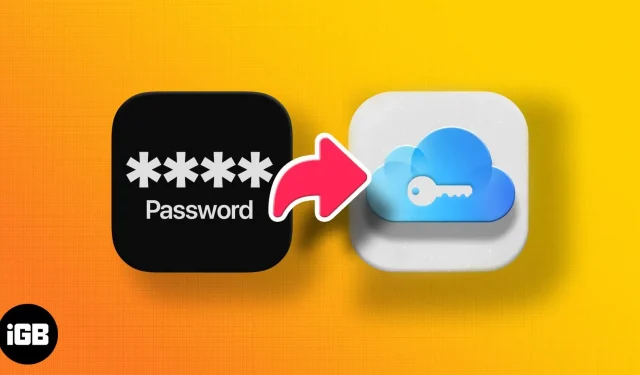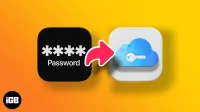I am sure that in this digital age you are logging into different accounts and entering your passwords more often than you would like to admit. This is where password managers come to the rescue. These handy tools remember and store all your logins and passwords so you don’t have to.
In the Apple ecosystem, everything has become even more accessible thanks to its own password manager called iCloud Keychain. If you’ve been using a third-party password manager so far and want to move everything to iCloud, you’ve come to the right place. I will teach you how to import your passwords into iCloud Keychain.
Before we continue
Here’s a small step: make sure iCloud Keychain is set up and enabled on your Apple device.
On your iPhone:
- Open Settings → tap [your name].
- Select iCloud → tap Keychain Access.
- Turn on the switch.
On your Mac (macOS Catalina or later):
- Go to System Preferences → Apple ID.
- Click iCloud in the sidebar → check the “Keychain Access”box.
Note. When using macOS Ventura, System Preferences is replaced by System Preferences.
On your Mac (macOS Mojave or earlier):
- Go to System Preferences → click iCloud.
- Check the “Keychain Access”box.
Manually import passwords to iCloud Keychain
The most direct but time-consuming way to import your passwords into your iCloud Keychain is to do it manually. Of course, it is very important to remember all your passwords.
You can manually import passwords via iPhone, iPad, or Mac. Because iCloud Keychain keeps all your passwords up to date on your Mac, iPhone, and other Apple devices, whatever you enter on one device will work across all devices.
How to manually import passwords on iPhone
Here’s how you can find and manage saved passwords on your iPhone or iPad:
- Go to “Settings”→ “Passwords”.
- Use Face ID, Touch ID or Passcode to open Passwords.
- Click the Add (+) button.
- Enter website, username and password.
- Click Done.
How to manually import passwords on Mac
- Finding passwords in Finder.
- Enter your password or use your Touch ID to access passwords.
- Click the Add (+) button → enter the website, your username and password next to the provided text fields.
- Click Add password.
Import passwords to Safari from Google Chrome or Firefox
To transfer all your passwords to iCloud Keychain, you need to import them into Safari on your Mac. While this sounds pretty simple, it’s not that simple. Why? Unlike other password managers, Safari does not allow you to import passwords from a CSV file.
However, Safari allows you to import passwords from Chrome or Firefox into Safari. So let me discuss the step by step process of importing your passwords into iCloud Keychain using Safari.
Step 1: Download the Chrome or Firefox browser.
The first thing you need to do (if you don’t already have them) is download Google Chrome or Firefox. One is enough.
Step 2: Obtain password CSV files from a third party application or service.
The next step is to get the CSV file from the third party password manager you are using. While the steps may vary depending on the application, I’ve covered the most common password managers below.
For Dashlane:
- Go to the Dashlane web app.
- Go to My Account → Data Export. You may be prompted to enter a master password.
- Select Export to CSV.
For the last pass:
- On your browser toolbar, click the LastPass browser extension.
- Go to “Account Settings”→ “Advanced”→ “Export”. Enter your master password when prompted.
- Select Continue.
- Your passwords will be downloaded as a CSV file to your downloads folder.
For 1Password:
- Launch the 1Password app on your computer.
- Go to File → Export → All Items. You will be prompted to enter a master password.
- Enter the filename and location where you want to save the item. Be sure to select CSV as the file format.
- Click Save.
Step 3: Import password CSV files into Chrome or Firefox.
Once you’ve finished uploading the CSV file, the next step is to import it into your preferred browser.
In your Chrome:
- Open Chrome.
- Enter chrome://flags in the address bar. Press Enter.
- Type import password in the search bar.
- Click the dropdown menu and select Enabled.
- Click Restart to restart Chrome.
- Click the three-dot menu icon → select Settings → click Passwords under Autofill.
- Scroll down to Saved Passwords → click the three dots icon → select Import.
- Select the CSV file you downloaded from the third party passport manager.
Firefox has currently disabled this feature due to performance issues. However, there is a workaround for this:
- Launch Firefox.
- Type about:config in the address bar → press Enter. A warning will appear. Click “Accept the Risk and Continue”.
- In the Settings search bar, type signon.management.page.fileImport.enabled → click the button on the side to change false to true.
- Click the three-dot menu → select Import from File.
- Select the saved CSV file → click Import.
- A pop-up window will appear showing how many logins have been added → click Finish.
Step 4. How to Import Passwords from Chrome or Firefox to Safari
Now that you’ve already imported your passwords into Chrome or Firefox, it’s time to import them from one of those browsers into Safari. Compared to the previous steps, this one is quite simple:
- Launch Safari on your Mac.
- Go to “File”→ “Import from”→ choose from the available browsers where you originally imported the CSV file.
- Check the items you want to import → click “Import”.
While you don’t have the ability to do this on your iPhone or iPad, there’s nothing to worry about. As long as iCloud Keychain is enabled on all your devices, you should be able to easily access all your passwords.
In addition, iCloud Keychain also helps you discover compromised, weak, and reused passwords stored in your keychain.
The process is similar if you want to export iCloud Keychain passwords from Safari to another browser or third party password manager. We will discuss this in another article.
Use a third party tool
If you don’t want to follow the strict steps above, you can take the help of third party tools like Tenorshare’s 4uKey. These applications allow you to import all passwords and website accounts from browsers and third party password managers.
If you’re still in doubt about which password manager to use and don’t want to do the hard work of syncing your passwords, you can choose from our list of the best password managers for your iPhone.
Meanwhile, if you are not very sure about iCloud Keychain for your Mac, you can also check out our roundup of the best password managers for your Mac.
FAQ
A. To sync iPhone Keychain passwords with other devices: 1. Go to Settings → tap [your name] → iCloud.2. Tap Keychain Access → turn on iCloud Keychain. Enter your password or Apple ID when prompted. Once you do this, you will be able to store your login from various websites and apps and access it from all your Apple devices.
A. If you used the Setup Assistant, your keychains are automatically transferred to the new computer. You can also export your keychains using Keychain Access on your Mac:1. Open the application → click “File”in the menu bar → “Export Items”.2. Select a location for the keychain items → click Save.3. Enter password.4. AirDrop or transfer the file to another computer. On another Mac:1. Open the app. 2. Select “File”→ “Import Items”.3. Find the file. 4. At the Target Keychain prompt, select the keychain you want to import to import into it → click Open.
A. One way to sync iCloud Keychain and Google passwords is to export them from one password manager and import them to another. You can also download the iCloud Passwords extension for Chrome to be able to use your passwords created in the Safari and Apple apps with Google Chrome.
Completion…
Password managers are essential tools that help you view and interact with your accounts seamlessly. However, this can become a problem if your saved items are not available on other devices or other browsers.
If you’re an Apple user, putting everything in iCloud Keychain ensures that your Mac, iPhone, or iPad automatically fills in all of your logins. You no longer need to force your brain to remember passwords!
Have you tried importing your passwords and account information to iCloud Keychain? What method did you do? Share them in the comments section!


